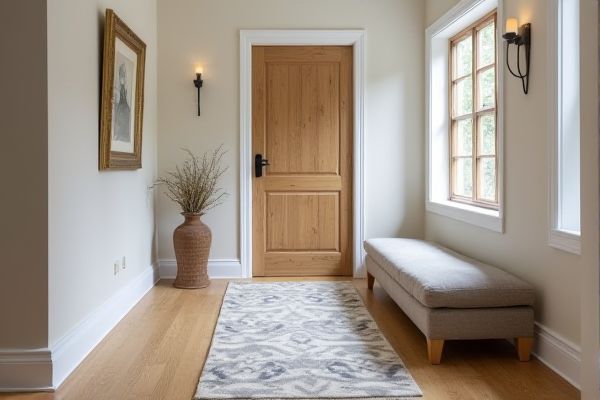
A hallway bench offers practical seating and storage options, often featuring hooks or shelves, making it ideal for organizing entryways, while an ottoman provides versatile comfort and style, frequently doubling as footrest or hidden storage in living spaces. Discover which option best suits Your home's needs by exploring the detailed comparisons in the rest of this article.
Table of Comparison
| Feature | Hallway Bench | Ottoman |
|---|---|---|
| Primary Use | Seating for putting on shoes, storage | Seating, footrest, occasional storage |
| Design | Long, narrow, usually with backrest | Compact, cushioned, no backrest |
| Storage | Often includes shelves or compartments | Usually a hollow interior with lift-up top |
| Placement | Entryway or hallway | Living room, bedroom, versatile |
| Material | Wood, metal, with upholstery | Upholstered foam, wood frame |
| Size | Longer length for seating multiple people | Smaller, square or rectangular form |
| Functionality | Seating plus organization/storage | Seating plus footrest and storage |
| Style | Traditional to modern hallway furniture | Contemporary to classic versatile piece |
Hallway Bench vs Ottoman: An Overview
A hallway bench offers structured seating with built-in storage options, ideal for organizing shoes or bags in entryways. An ottoman provides versatile, cushioned seating and can double as a footrest or extra surface, often featuring hidden storage for added convenience. Your choice depends on the balance between functionality, style, and space utilization in your hallway.
Key Differences in Design and Functionality
Hallway benches typically feature a sturdy frame with a backrest and storage compartments, designed to provide seating and organizational solutions for entryways. Ottomans are more versatile, often lightweight and cushioned, serving as footrests, extra seating, or decorative accents without built-in storage. Your choice depends on whether you prioritize structured seating and storage or flexible, movable furniture for your hallway.
Space Optimization: Bench or Ottoman?
A hallway bench typically offers built-in storage options like shelves or compartments, making it ideal for organizing shoes and accessories while providing seating. Ottomans often feature hidden storage inside but generally occupy less visual space, allowing for a flexible footprint in narrower hallways. Choosing between a bench or ottoman for space optimization depends on the hallway dimensions and storage needs, with benches suited for larger areas and ottomans fitting compact spaces.
Comfort and Seating Capacity
A hallway bench typically offers structured seating with a backrest or armrests, enhancing comfort during extended use, while an ottoman provides versatile, cushioned seating without support, ideal for short rests or casual use. Benches often accommodate two to three people depending on size, increasing seating capacity in narrow hallways, whereas ottomans vary widely in size, ranging from single seating to larger ottoman benches that hold multiple users. Choosing between the two depends on the desired balance between ergonomic comfort and flexible seating options in hallway spaces.
Storage Solutions: Bench vs Ottoman Comparison
Hallway benches often feature built-in storage compartments or lift-up seats, allowing for organized space to store shoes, umbrellas, or seasonal accessories. Ottomans offer versatile storage with hidden interior space, ideal for smaller items or extra blankets, but typically provide less seating compared to benches. Choosing between a bench and an ottoman depends on the hallway's size and storage needs, balancing accessibility and the volume of items to be stored.
Style and Aesthetic Appeal
A hallway bench often features a structured design with visible legs and a backrest, lending a classic or rustic charm that complements traditional or farmhouse interiors. Ottomans, by contrast, provide a sleek, upholstered look with soft, rounded edges that suit modern and contemporary styles, offering a versatile piece that can double as extra seating or a footrest. Your choice between the two can significantly impact the hallway's ambiance, with benches emphasizing formality and ottomans enhancing comfort and casual elegance.
Durability and Material Choices
Hallway benches typically feature sturdy hardwood frames and durable upholstery designed to withstand frequent use, making them a long-lasting choice for entryways. Ottomans, often crafted with softer materials like fabric or leather and filled with foam, provide comfort but may wear out faster under heavy foot traffic. When selecting for durability, consider your hallway's usage; your choice between a bench or ottoman should balance material strength and maintenance needs.
Versatility in Home Decor
A hallway bench offers versatile functionality by providing seating and storage options, often featuring shelves or compartments to organize shoes and accessories, making it ideal for entryways. An ottoman enhances home decor versatility with its dual role as a footrest and additional seating, frequently incorporating hidden storage for blankets or magazines to maintain a clutter-free space. Both pieces adapt to various interior styles, contributing practical elegance to any hallway or living area.
Budget Considerations: Cost Comparison
Hallway benches typically range from $100 to $400 depending on materials and design complexity, while ottomans generally cost between $50 and $300, offering a more budget-friendly option. Benches often provide added storage or seating features that may justify their higher price point, whereas ottomans are versatile but usually lack built-in storage. Evaluating cost against functionality is essential for optimizing hallway furniture investment.
Choosing the Right Option for Your Space
When choosing between a hallway bench and an ottoman, consider your space's functionality and style needs; a hallway bench offers built-in storage and seating ideal for entryways, while an ottoman provides versatile comfort and can double as a coffee table or footrest. Assess the dimensions of your hallway and whether additional storage or seating is a priority to maximize usability without overcrowding the area. Your selection should balance aesthetic appeal and practical use to enhance the flow and organization of your space effectively.
 homyna.com
homyna.com